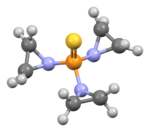Chemistry:Thiotepa
| |||
| Clinical data | |||
|---|---|---|---|
| Trade names | Tepadina | ||
| AHFS/Drugs.com | Monograph | ||
| MedlinePlus | a682821 | ||
| License data | |||
| Pregnancy category |
| ||
| Routes of administration | Intravenous, intracavitary, intravesical | ||
| ATC code | |||
| Legal status | |||
| Legal status | |||
| Pharmacokinetic data | |||
| Metabolism | Liver (CYP2B6, CYP3A) | ||
| Elimination half-life | 1.5–4.1 hours | ||
| Excretion | Kidney 6 hours for thiotepa 8 hours for TEPA | ||
| Identifiers | |||
| |||
| CAS Number | |||
| PubChem CID | |||
| IUPHAR/BPS | |||
| DrugBank | |||
| ChemSpider | |||
| UNII | |||
| KEGG | |||
| ChEMBL | |||
| Chemical and physical data | |||
| Formula | C6H12N3PS | ||
| Molar mass | 189.22 g·mol−1 | ||
| 3D model (JSmol) | |||
| |||
| |||
| | |||
Thiotepa (INN[4]), sold under the brand name Tepadina, is a medication used to treat cancer.[2][3][5]
Thiotepa is an organophosphorus compound with the formula (C2H4N)3PS.[6] It is an analog of N,N′,N″-triethylenephosphoramide (TEPA), which contains tetrahedral phosphorus and is structurally akin to phosphate. It is manufactured by heating aziridine with thiophosphoryl chloride.[citation needed]
Medical uses
Thiotepa is indicated for use in combination with other chemotherapy agents to treat cancer.[2][3][5] This can be with or without total body irradiation (TBI), as a conditioning treatment prior to allogeneic or autologous hematopoietic progenitor cell transplantation (HPCT) in hematological diseases in adults and children.[3][5] These diseases include Hodgkin's disease and leukaemia.[5] Thiotepa is also used with high-dose chemotherapy with HPCT support to treat certain solid tumors in adult and children.[3][5]
Thiotepa is used in the palliation of many neoplastic diseases. The best results are found in the treatment of adenocarcinoma of the breast, adenocarcinoma of the ovary, papillary thyroid cancer and bladder cancer. Thiotepa is used to control intracavitary effusions caused by serosal neoplastic deposits.[5]
Intravesical use
Thiotepa is used as intravesical chemotherapy in bladder cancer.[7]
It may be used prophylactically to prevent seeding of tumor cells at cystoscopic biopsy; as an adjunctive agent at the time of biopsy; or as a therapeutic agent to prevent recurrence after cystoscopic resection of bladder tumor (transurethral resection of bladder tumor, TURBT). Efficacy in tumor control may reach 55%. The main toxicity of this therapy is bone marrow suppression due to systemic absorption of the drug.
Side effects
The main side effect of thiotepa is bone marrow suppression resulting in leukopenia, thrombocytopenia and anemia.[8] Liver and lung toxicity may also occur.
History
Thiotepa was developed by the American Cyanamid company in the early 1950s and reported to media outlets in 1953.[9] In 1959, thiotepa was registered with the Food and Drug Administration (FDA) as a drug therapy for several solid cancers.[10]
On January 29, 2007, the European Medicines Agency (EMA) designated thiotepa as an orphan drug. On April 2, 2007, the United States FDA designated thiotepa as a conditioning treatment for use prior to hematopoietic stem cell transplantation.[11]
References
- ↑ "Tepadina (Link Medical Products Pty Ltd T/A Link Pharmaceuticals)". 28 September 2022. https://www.tga.gov.au/resources/prescription-medicines-registrations/tepadina-link-medical-products-pty-ltd-ta-link-pharmaceuticals.
- ↑ 2.0 2.1 2.2 "Tepadina- thiotepa injection, powder, for solution". https://dailymed.nlm.nih.gov/dailymed/drugInfo.cfm?setid=559e353c-2dc0-16ba-e054-00144ff8d46c.
- ↑ 3.0 3.1 3.2 3.3 3.4 "Tepadina EPAR". 17 September 2018. https://www.ema.europa.eu/en/medicines/human/EPAR/tepadina.
- ↑ "International Non-Proprietary Names for Pharmaceutical Preparations. Recommended International Non-Proprietary Names (Rec. I.N.N.): List 4". World Health Organization. March 1962. p. 111. https://www.who.int/medicines/publications/druginformation/innlists/RL04.pdf.
- ↑ 5.0 5.1 5.2 5.3 5.4 5.5 "Urgent, Thiotepa update". U.S. Food and Drug Administration (FDA). 5 April 2011. https://www.fda.gov/downloads/Drugs/DrugSafety/DrugShortages/UCM251666.pdf.
- ↑ "Chemistry, pharmacology and pharmacokinetics of N,N',N" -triethylenethiophosphoramide (ThioTEPA)". Cancer Treatment Reviews 26 (4): 257–68. August 2000. doi:10.1053/ctrv.2000.0170. PMID 10913381.
- ↑ Urothelial Tumors. PMPH-USA. 2004. p. 207. ISBN 978-1-55009-173-1. https://books.google.com/books?id=q19Iox_cJNUC&pg=PA207. Retrieved 2017-09-16.
- ↑ "Early onset life-threatening myelosuppression after low dose of intravesical thiotepa". Postgraduate Medical Journal 58 (680): 380–1. June 1982. doi:10.1136/pgmj.58.680.380. PMID 6812036.
- ↑ "Clinical studies on triethylenephosphoramide and diethylenephosphoramide, compounds with nitrogen-mustard-like activity". Cancer 6 (1): 142–148. 1953. doi:10.1002/1097-0142(195301)6:1<142::AID-CNCR2820060114>3.0.CO;2-W.
- ↑ Cancer Drug Discovery: Science and History. Springer. 2016. pp. 82. ISBN 978-94-024-0844-7.
- ↑ "EMA Grants Adienne Marketing Rights for Tepadina". dddmag.com. Drug Discovery & Development. 19 March 2010. http://www.dddmag.com/news-EMA-Grants-Adienne-Marketing-Rights-for-Tepadina-31910.aspx.
 |



